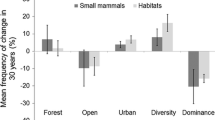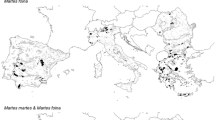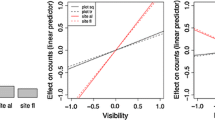Abstract
Pellet counts have been used to measure habitat selection of a variety of ungulate species often under the assumption that this method gives an unbiased sample of the true distribution of the species among habitats. The validity of this method has been questioned and comparisons with other methods have sometimes showed divergent results. We tested the validity of pellet group distribution as a tool for habitat selection studies by comparing the distribution of moose pellet groups in four different forest age categories (forest age <30, 31–60, 61–90, >90 years) and mire with GPS positions from collared moose (Alces alces). Sample plots (n = 531) were cleaned from pellet during the fall 2007 and the number of new pellet groups were counted in spring 2008, thus resulting in a defined period of accumulation. In addition, pellet groups were counted in paired, uncleaned, control plots. GPS data from 15 collared moose monitored during the same period were used for comparison with habitat composition and distribution of pellet groups. Both the distribution of pellet groups and GPS positions differed significantly from the habitat composition within the study area. Young forest stands (<30 years) were significantly more used than both forests >30 years and mire. The selection by moose, as calculated by Manly’s alpha, showed identical ranking among habitat classes for cleaned sample plots and GPS data whereas uncleaned plots showed a shifted rank order for two of the habitat classes. We conclude that pellet group counts can be used to accurately predict habitat use for moose during winter.



Similar content being viewed by others
References
Aebischer NJ, Robertson PA, Kenward RE (1993) Compositional analysis of habitat use from animal radio-tracking data. Ecology 74:1313–1325
Andersen R, Hjeljord O, Sæther B-E (1992) Moose defecation rates in relation to habitat quality. Alces 28:95–100
Arnemo JM, Kreeger TJ, Soveri T (2003) Chemical immobilization of free-ranging moose. Alces 39:243–253
Ball JP, Danell K, Sunesson P (2000) Response of a herbivore community to increased food quality and quantity: an experiment with nitrogen fertilizer in a boreal forest. J Appl Ecol 37:247–255
Bowman JL, Kochanny CO, Demarais S, Leopold BD (2000) Comparison of pellet-group and radio triangulation methods for assessing deer habitat use. Wildl Soc Bull 28:141–145
Cederlund G, Okarma H (1988) Home range of moose and habitat use of adult female moose. J Wild Man 52:336–343
Collins WB, Urness PJ (1981) Habitat preferences of mule deer as rated by pellet-group distributions. J Wild Man 45:969–972
D’Eon RG, Serrouya R, Smith G, Kochanny CO (2002) GPS radiotelemetry error and bias in mountainous terrain. Wildl Soc Bull 30:430–439
Dussault C, Courtois R, Ouellet JP, Huot J (1999) Evaluation of GPS telemetry collar performance for habitat studies in the boreal forest. Wildl Soc Bull 27:965–972
Dussault C, Courtois R, Ouellet JP, Huot J (2001) Influence of satellite geometry and differential correction on GPS location accuracy. Wildl Soc Bull 29:171–179
Edge WD, Marcum CL (1989) Determining elk distribution with pellet-group and telemetry techniques. J Wild Man 53:621–624
Fieberg J, Matthiopoulos J, Hebblewhite M, Boyce MS, Frair JL (2010) Correlation and studies of habitat selection: problem, red herring or opportunity? Philos Trans R Soc Lond B Biol Sci 365:2233–2244
Franzmann AW, Schwartz CC (1997) Ecology and management of the North American moose, 1st edn. Smithsonian Institution Press, USA
Guillet C, Bergström R, Cederlund G, Bergström J, Ballon P (1995) Comparison of telemetry and pellet-group counts for determining habitat selectivity by roe deer (Capreolus capreolus) in winter. J Gibi Faun Sau 12:253–269
Johnson H (1980) The comparison of usage and availability measurements for evaluating resource preference. Ecology 6:65–71
Kardell L (1980) Occurrence and production of bilberry, lingonberry and raspberry in Sweden’s forests. For Ecol Manage 2:285–298
Krebs CJ (1999) Ecological methodology, 2nd edn. Benjamin/Cummings, Menlo park
Lavsund S (1975) Investigations on pellet groups. Research notes 23. Royal College of Forestry. Stockholm. In Swedish with English summary
Lavsund S, Nygren S, Solberg EJ (2003) Status of moose population and challenges to moose management in Fennoscandia. Alces 39:109–130
Leban FA (1999) Resource selection for Windows: user’s guide. University of Idaho, Moscow
Leopold BD, Krausman PR, Hervert JJ (1984) Comment: the pellet-group census technique as an indicator of relative habitat use. Wildl Soc Bull 12:325–326
Litvaitis JA, Sherburne JA, Bissonette JA (1985) A comparison of methods used to examine snowshoe hare habitat use. J Wild Man 49:693–695
Loft ER, Kie JG (1988) Comparison of pellet-group and radio triangulation methods for assessing deer habitat use. J Wild Man 52:524–527
Manly BFJ, Miller P, Cook LM (1972) Analysis of a selective predation experiment. Am Nat 106:719–736
Månsson J (2009) Environmental variation and moose Alces alces density as determinants of spatio-temporal heterogeneity in browsing. Ecography 32:601–612
Månsson J, Andren H, Pehrson A, Bergstrom R (2007) Moose browsing and forage availability: a scale-dependent relationship? Can J Zool 85:372–380
Miquelle DG, Peek JM, Ballenberghe VV (1992) Sexual segregation in Alaskan moose. Wildl Monogr 122:3–57
Moen R, Pastor J, Cohen Y, Schwartz CC (1996) Effects of moose movement and habitat use on GPS collar performance. J Wild Man 60:659–668
Moen R, Pastor J, Cohen Y (1997) Accuracy of GPS telemetry collar locations with differential correction. J Wild Man 61:530–539
Neff DJ (1968) The pellet-group count technique for big game trend, census, and distribution: a review. J Wild Man 32:597–614
Neu CW, Byers CR, Peek JM (1974) A technique for analysis of utilization-availability data. J Wild Man 38:541–545
Olsson M, Cox JJ, Larkin JL, Widén P, Olovsson A (2010) Space and habitat use of moose in southwestern Sweden. Eur J Wildl Res. doi:10.1007/s10344-010-0418-5
Persson IL (2003) Seasonal and habitat differences in visibility of moose pellets. Alces 39:233–241
Pradhan NMB, Wegge P (2007) Dry season habitat selection by a recolonizing population of Asian elephants Elephas maximus in lowland Nepal. Acta Theriol 52:205–214
Putman RJ (1984) Facts from feces. Mammal Rev 14:79–97
Rempel RS, Rodgers AR (1997) Effects of differential correction on accuracy of a GPS animal location system. J Wildl Manage 61:525–530
Rempel RS, Rodgers AR, Abraham KF (1995) Performance of a GPS animal location system under boreal forest canopy. J Wildl Manage 59:543–551
Rodgers AR, Rempel RS, Abraham KF (1996) A GPS-based telemetry system. Wildl Soc Bull 24:559–566
Rönnegård L, Sand H, Andrén H, Månsson J, Pehrson Å (2008) Evaluation of four methods used to estimate population density of moose Alces alces. Wildl Biol 14:358–371
Van Beest MF, Loe LE, Mysterud A, Milner JM (2010) Comparative space use and habitat selection of moose around feeding stations. J Wild Man 74:219–227
White GC, Garrot RA (1990) Analysis of wildlife radio-tracking data. Academic Press, London
Acknowledgments
The work was supported by grants from the private foundation “Marie-Claire Cronstedts stiftelse” and The Swedish Environmental Protection Agency within the research programme “Adaptive management of fish and wildlife populations.” We also thank Sveaskog for the cooperation in this study.
Author information
Authors and Affiliations
Corresponding author
Additional information
Communicated by G. Nugent
Rights and permissions
About this article
Cite this article
Månsson, J., Andrén, H. & Sand, H. Can pellet counts be used to accurately describe winter habitat selection by moose Alces alces?. Eur J Wildl Res 57, 1017–1023 (2011). https://doi.org/10.1007/s10344-011-0512-3
Received:
Revised:
Accepted:
Published:
Issue Date:
DOI: https://doi.org/10.1007/s10344-011-0512-3




